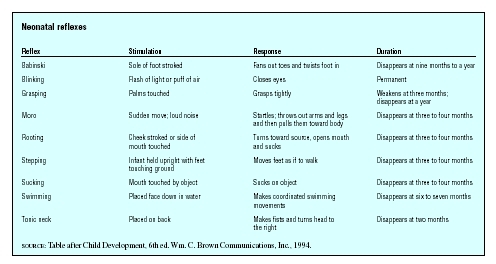Soon after birth your child is given an Apgar score. APGAR stands for Appearance, Pulse, Grimace, Activity, and Respiration. Babies tend to undergo this test 1 minute and 5 minutes after birth (and occasionally again at 10 minutes after birth). In each of the 5 categories your baby is scored on a 0-2 scale (0 meaning absent or non-existent, 2 meaning active and normal). Appearance tests skin coloration, Pulse tests heart rate, Grimace tests reflexes, Activity tests muscle tone and Respiration tests the rate and effort of breathing.
While most categories in the Apgar scoring system are obvious (color: pink skin, pulse: over 100 bpm, etc.) the Grimace or reflex irritability category could potentially test any number of things. What doctors and nurses are testing for is the babies reaction to a stimulus- like a mild pinch. This could also be tested by suctioning the infants airways and noting their reaction- do they cough, pull away and/or sneeze? Essentially they are trying to irritate the child to see how they respond. Their response is based upon their reflex reactions.
Some of the reflexes a person is born with include:
-Moro reflex (startle reaction) -Truncal Incurvation (Galant reflex)
Some of the reflexes a person is born with include:
-Moro reflex (startle reaction) -Truncal Incurvation (Galant reflex)
-Sucking reflex -Rooting reflex
-Step reflex -Parachute reflex
-Tonic Neck reflex - Blinking, cough, sneeze, yawn and gag reflexes
-Grasp reflex (Palmer) -Plantar reflex
-Swimming reflex -Babkin reflex
Reflexes are protective reactions involving the spinal cord. When a receptor picks up a stimulus an impulse starts. A reflex sensory reaction occurs when it first travels through sensory neurons, then interneurons in the brain and spinal cord and then the motor neurons in muscles.
It is hard to understand the reasoning behind some reflex's and what their purpose is in the survival of an infant, for instance tonic neck and the Babinski reflexes appear to serve little to no purpose. The Moro reflex, however may have played a part in our evolutionary history. Much like the primates of today we carried our young all day long, and if an infant lost its balance the Moro reflex is believed to have caused the child to grasp onto the mother to regain its hold. The rooting reflex is a reflex that still greatly assists an infant in learning to breastfeed. Research suggests that after continuously being breastfed for 3 weeks starting from birth an infant no longer relies on the reflex and is instead drawn to the nipple from habit. What is important to note is that no matter if a reflex appears to serve no purpose now, they often still have a functional significance that allows a child to reach developmental milestones, ie. the body righting reaction will help a child roll over when they are later capable.
Many of the primitive reflexes disappear after a very short time. Most, in fact, disappear before the age of one. If a reflex persists for an extended period of time it may suggest there is something wrong neurologically with the infant. At birth, and at at least the first few months of check ups the pediatrician will test some of an infants reflexes as a way of checking for any issues with either this persistence or utter lack of a reflex. For example, if there is asymmetry while checking the reaction of the Moro reflex, it could indicate a brain injury or lesion or perhaps a peripheral nerve problem to the upper extremity or if there is persistence of the Galants reflex beyond 2 months could suggest atheltoid cerebral palsy.
Many of the primitive reflexes disappear after a very short time. Most, in fact, disappear before the age of one. If a reflex persists for an extended period of time it may suggest there is something wrong neurologically with the infant. At birth, and at at least the first few months of check ups the pediatrician will test some of an infants reflexes as a way of checking for any issues with either this persistence or utter lack of a reflex. For example, if there is asymmetry while checking the reaction of the Moro reflex, it could indicate a brain injury or lesion or perhaps a peripheral nerve problem to the upper extremity or if there is persistence of the Galants reflex beyond 2 months could suggest atheltoid cerebral palsy.





No comments:
Post a Comment